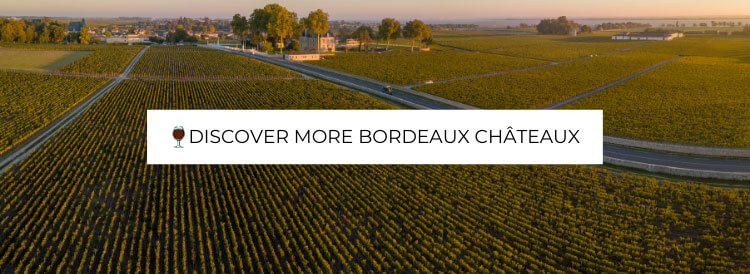Terroir (pronounced tare|WAHr) is a word visitors to Bordeaux will hear a lot when visiting Bordeaux’s châteaux. Terroir is the basis for the AOC (appellation d’origine contrôlée) system, and the French strongly believe that terroir, or the terrain, gives unique qualities to the wine that are specific to that growing plot and that plot alone. A visit to Château Canon-la-Gaffelière focuses on the uniqueness each plot gets from its’ terroir with a horizontal tasting of wines from three of the Neipperg family estates.

The History of Château Canon-la-Gaffelière
The site of what would eventually become Château Canon-la-Gaffelière has an interesting history. It can trace its roots back to the 17th century, and part of the name is a nod to the leper colony that once lived on the land.
The Count of Malet-Roquefort bought the entire domain, including the land of the leper colony, in the 17th century and built a castle on it. The Count left the cultivation of the land up to sharecroppers, and vineyards were planted along with beets and grains.
The first wine sold from La Gaffelière was recorded by Beylot & Fils, a wine merchant in Libourne, in 1777. But the château didn’t really come in to prominence until it was purchased by the Boitard de la Poterie family in the 1800s and operated under the name La Gaffelière-Boitard. The purchase encompassed what would eventually become two separate Saint-Émilion châteaux.
The heiress of the Boitard de la Poterie family married in to the Peyraud family, and the estate became part of the Peyraud’s holdings. After over a century in the Peyraud family, the race car driver and mayor of Saint-Émilion Pierre Meyrat purchased Château Canon-la-Gaffelière in 1953.
The estate, along with two others in Saint-Émilion and an estate in the Castillon appellation not far from Saint-Émilion, were purchased by Count Joseph Hubert von Neipperg in 1971. It sounds like an ambitious purchase, but the Neippergs already had wine making experience in Germany that dates back to the 13th century. The family even added a fifth estate located in Saint-Émilion to their portfolio of Bordeaux properties later on.
Château Canon-la-Gaffelière and the other Saint-Émilion and Castillon estates are still owned by the Neipperg family today. All the estates are managed by the Count’s son, Stephan von Neipperg, who lives in part of the château at Château Canon-la-Gaffelière just above the barrel rooms.
Unlike the 1855 Classification of the Médoc, the Saint-Émilion Classification only started in 1955 and is re-examined every 10 years, with the most recent update to the classification completed in 2012. Château Canon-la-Gaffelière was classified with the prestigious status of Saint-Émilion Premier Grand Cru Classé B status in 2012.

The Visit at Château Canon-La-Gaffelière
Château Canon-la-Gaffelière has been officially certified organic since 2014, though the change to organic farming practices started many years before. The majority of the visit takes place in the vineyard with a focus on the estate’s organic farming practices.
The château and 19.5 hectares of vines are located at the foot of the Saint-Émilion plateau just south of the medieval village. Here the terroir is clay-limestone and clay-sand, which retains heat and naturally protects the vines from spring frost.
The vines at Château Canon-la-Gaffelière are quite old, with the average age of 50 years. There’s even some plots that are 80 year old. While vines this age have a lower yield, the grapes are more even in terms of quality.

What’s also particularly interesting is that Château Canon-la-Gaffelière doesn’t purchase already grafted vines. They only purchase rootstock, then graft their own vines on to the rootstock when it reaches two years of age.
It’s interesting to learn that they found even the amount of pressure put on the land can affect the organisms and such in the soil, so the use of tractors is minimized. Instead, Château Canon-la-Gaffelière has returned to using horses to plow and robotic lawn mowers to mow the grass in the plots.
In the winery, we learned that the grapes are not crushed before going in to the vats. They are naturally crushed by their own weight during the fermentation in wooden temperature controlled vats. Only a few stainless steel and concrete vats are used for the Cabernet Franc and Cabernet Sauvignon.

Of course, we had a look at the barrel room where the most recent vintage is aging in mostly new French oak barrels.
Nearly all the wine from Château Canon-la-Gaffelière is sold to merchants or exported, so there isn’t a large cellar with stock. Only enough wine for visits and to be sold onsite is held back.


The tasting room is in the former vat house, and it’s a beautiful space to end the visit in. There’s four tall glass vases with the soil composition to help visitors easily visual the different terroir from each of the Saint-Émilion and Castillon estates.

This is interesting because you taste not only the wine of Château Canon-la-Gaffelière, but also from Château d’Aiguilhe in Castillon and Clos de L’Oratoire in Saint-Émilion. It isn’t until a tasting like this in which you’re tasting wines produced by the same team, that you can really appreciate how different the terroir can make each wine.
We must note La Mondotte is a small estate of just 4.5 hectares with an extremely limited production. The blend is 75% Merlot and 25% Cabernet Franc, and is a powerful wine meant to be aged. It’s not typically part of the visit, with the exception of visits for wine professionals like negotiants. But this wine silky and elegant, reminding us more of a Left Bank wine than a Right Bank. A small amount is available for purchase at Château Canon-la-Gaffelière.
Know Before You Go
This article contains affiliate links. When you book on Trainline through our affiliate sites, we earn a small commission at no additional cost to you.


Leave a Reply